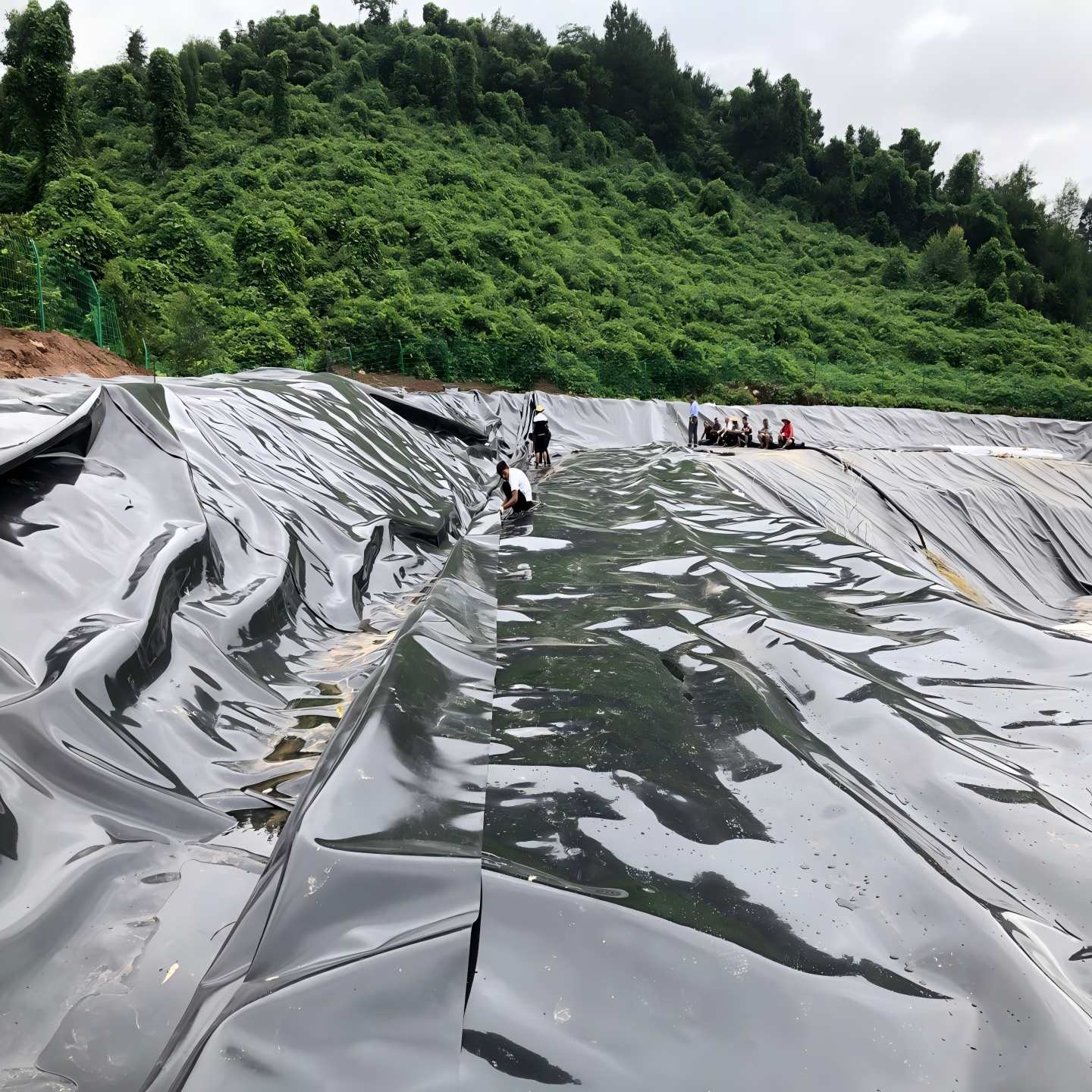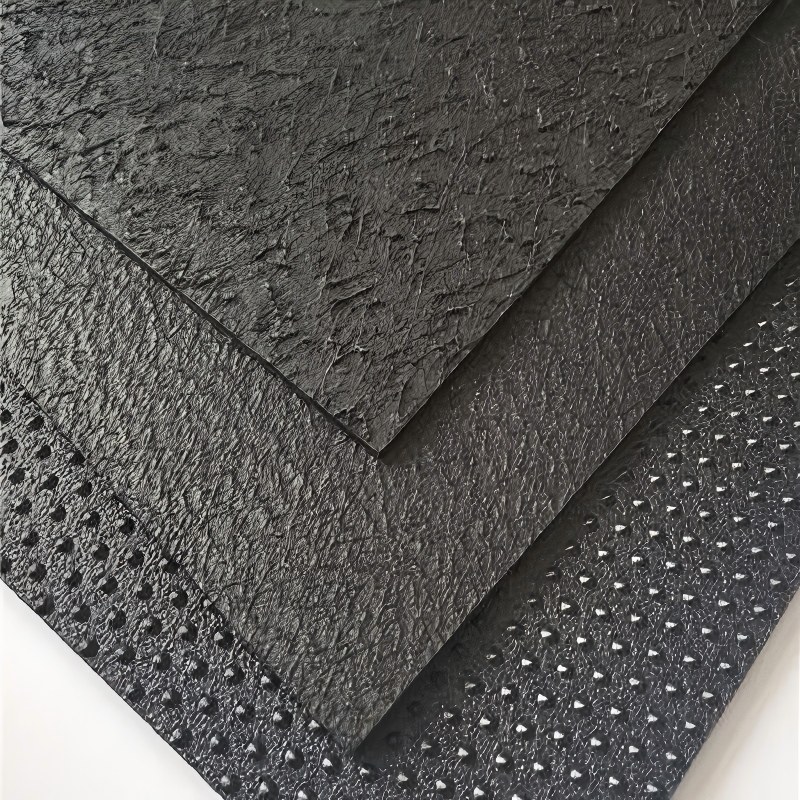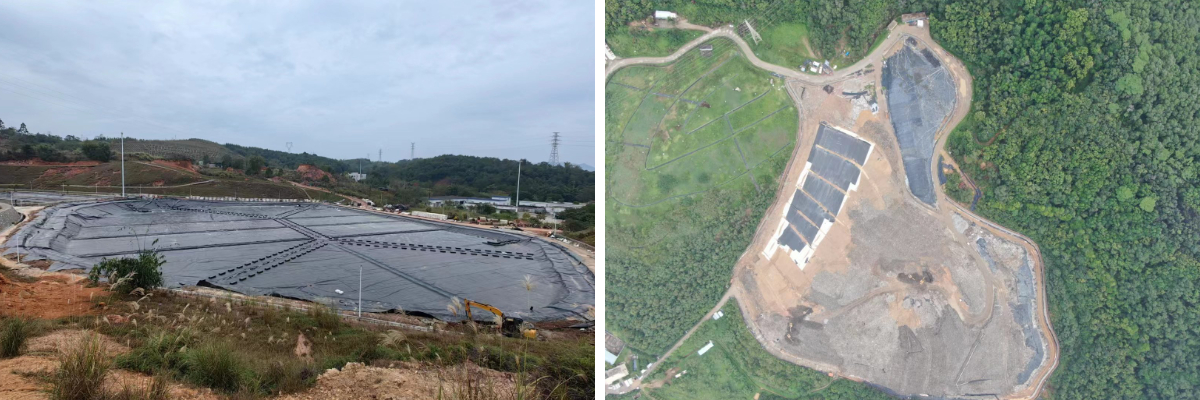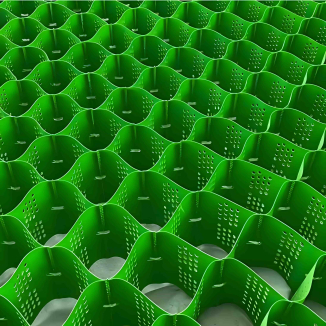HDPE Geo Membrane
1.Strong Anti-Leakage Capacity:
Resistant to penetration by acid-base-salt solutions, oil, chemical waste liquids, etc., ideal for high-seepage-control scenarios like landfills and wastewater treatment plants.
2.High Tensile Strength:
HDPE geomembranes offer tensile strength up to 15~35 MPa and elongation at break exceeding 700%, adapting to foundation settlement or deformation without cracking.
3.High Construction Efficiency:
Lightweight and rollable, reducing transportation costs. Installation speed is over 60% faster than traditional concrete liners.
Product Introduction:
HDPE Geo Membrane is a water-impermeable film formed by blow molding, calendering, or compounding polymer materials such as polyethylene (PE), polypropylene (PP), and ethylene-vinyl acetate copolymer (EVA). It is primarily used to block liquid penetration and serves as a core material in modern engineering seepage prevention systems.
Performance Characteristics
1.Anti - seepage Performance: Geomembranes possess an extremely low permeability coefficient, enabling them to effectively prevent the penetration of liquids and the leakage of water, chemicals, etc., thus ensuring the anti - seepage effect of engineering projects.
2.Chemical Stability: They exhibit good corrosion resistance to a variety of acids, alkalis, salts, and other chemicals, allowing for long - term use in different chemical environments.
3.Mechanical Properties: Geomembranes have a certain degree of strength and elongation, enabling them to withstand certain external forces, such as tension, tearing, and puncturing, to guarantee the safety and stability of engineering projects.
4.Aging Resistance: In the natural environment, geomembranes are subject to aging due to factors like ultraviolet rays, oxygen, and temperature. High - quality geomembranes are usually added with anti - aging agents to extend their service life.
5.Construction Performance: Geomembranes are lightweight and have good flexibility, making them convenient for transportation and laying. They can be connected by methods such as welding and bonding, resulting in easy and efficient construction.
Product Parameters:
Metric | ASTM | unit | Test value | Minimum test frequency | ||||||
| test method | 0.75 mm | 1.00 mm | 1.25 mm | 1.50 mm | 2.00 mm | 2.50mm | 3.00 mm | |||
| Minimum average thickness | D5199 | mm | 0.75 | 1 | 1.25 | 1.5 | 2 | 2.5 | 3 | Per volume |
| Minimum value (any one of 10) | -10% | -10% | -10% | -10% | -10% | -10% | -10% | |||
| minimum density | D 1505/D 792 | g/cm3 | 0.94 | 0.94 | 0.94 | 0.94 | 0.94 | 0.94 | 0.94 | 90,000 kg |
| Minimum average tensile performance (1) | D638 Type IV | |||||||||
| Breakage strength, | N/mm | 20 | 27 | 33 | 40 | 53 | 67 | 80 | 9,000 kg | |
| yield strength | N/mm | 11 | 15 | 18 | 22 | 29 | 37 | 44 | ||
| Strain extension, | % | 700 | 700 | 700 | 700 | 700 | 700 | 700 | ||
| yield extension | % | 12 | 12 | 12 | 12 | 12 | 12 | 12 | ||
| Minimum strength of right-angle tear | D 1004 | N | 93 | 125 | 156 | 187 | 249 | 311 | 374 | 20,000 kg |
| Minimum puncture strength | D4833 | N | 240 | 320 | 400 | 480 | 640 | 800 | 960 | 20,000 kg |
| Constant tensile load stress cracking (2) | D5397 | hour | 300 | 300 | 300 | 300 | 300 | 300 | 300 | Based on GRI GM-10 |
| Carbon black content | D 1603(3) | % | 2.0-3.0 | 2.0-3.0 | 2.0-3.0 | 2.0-3.0 | 2.0-3.0 | 2.0-3.0 | 2.0-3.0 | 9,000 kg |
| Carbon black dispersion | D5596 | Note (4) | Note (4) | Note (4) | Note (4) | Note (4) | Note (4) | Note (4) | 20,000 kg | |
| Oxygen induction time (OIT) (5) | 90,000 kg | |||||||||
| (a) Standard OIT | D3895 | minute | 100 | 100 | 100 | 100 | 100 | 100 | 100 | |
| (b) high-handed OIT | D5885 | minute | 400 | 400 | 400 | 400 | 400 | 400 | 400 | |
| 85℃ Oven aging (minimum average) (5)(6) | Per formula | |||||||||
| (A) Standard OIT is retained after 90 days | D 5721 | % | 55 | 55 | 55 | 55 | 55 | 55 | 55 | |
| (B) High voltage OIT is retained for 90 days | D 3895 D5885 | % | 80 | 80 | 80 | 80 | 80 | 80 | 80 | |
| Ultraviolet resistance (7) | Per formula | |||||||||
| (a) standard OIT | D3895 | Note (8) 50 | ||||||||
| (b) Retention of high pressure OIT after 1600 hours (9) | D5885 | % | ||||||||
Product Applications:
1.Hydraulic Engineering:
Seepage prevention and reinforcement for reservoirs, channels, and dams.
2.Environmental Protection Engineering:
Anti-seepage systems for landfills, sewage treatment plants, and hazardous waste storage yards.
3.Transportation Engineering:
Waterproof cushion layers for tunnels and subways, seepage prevention and drainage for highway slopes.
4.Energy Engineering:
Seepage prevention for oilfield drilling fluid pits, moisture-proof layers for LNG storage tank foundations.
5.Agricultural Engineering:
Seepage prevention for fish ponds and water storage tanks, isolation layers for saline-alkali land improvement.













